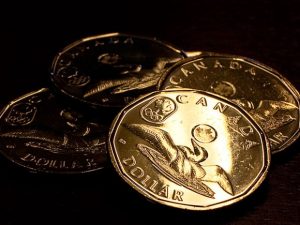 Yesterday’s trade saw USD/CAD within the range of 1.2826-1.2943. The pair closed at 1.2912, edging up 0.31% on a daily basis. It has been the 61st gain in the past 117 trading days and also a fifth consecutive one. The daily high has been the highest level since June 6th, when a high of 1.2984 was registered. USD/CAD has gone down 1.03% so far in June, following a 4.31% surge in the prior month.
Yesterday’s trade saw USD/CAD within the range of 1.2826-1.2943. The pair closed at 1.2912, edging up 0.31% on a daily basis. It has been the 61st gain in the past 117 trading days and also a fifth consecutive one. The daily high has been the highest level since June 6th, when a high of 1.2984 was registered. USD/CAD has gone down 1.03% so far in June, following a 4.31% surge in the prior month.
At 7:02 GMT today USD/CAD was gaining 0.43% on the day to trade at 1.2967. The pair touched a daily high at 1.2969 at 7:01 GMT, undershooting the upper range breakout level (R4), and a daily low at 1.2895 during the early phase of the Asian trading session.
Canadas dollar retreated for a fifth straight day against its US counterpart, as crude oil futures tested lows unseen since May 19th on Wednesday. Crude oil marked its 60th drop out of the past 128 trading days on June 15th. Oil for July delivery went down as low as $47.28 per barrel and closed at $47.47, plunging 2.10% compared to Tuesday’s close. As of 7:08 GMT today the commodity was inching down 0.04% to trade at $47.45, after going down as low as $47.38 per barrel earlier.
On Thursday USD/CAD trading may be influenced by the following macroeconomic reports as listed below.
Fundamentals
United States
Initial, Continuing Jobless Claims
The number of people in the United States, who filed for unemployment assistance for the first time during the business week ended on June 10th, probably rose to 270 000, according to market consensus, from 264 000 in the preceding week. The latter has been the lowest number of claims since the business week ended on April 22nd, when an unrevised level of 257 000 was reported.
The 4-week moving average, an indicator lacking seasonal effects, was 269 500, marking a decrease by 7 500 compared to the preceding weeks revised up average.
The business week, which ended on June 3rd has been the 66th consecutive week, when jobless claims stood below the 300 000 threshold, which suggested a healthy labor market. It has been the longest streak in 43 years.
Initial jobless claims number is a short-term indicator, reflecting lay-offs in the country. In case the number of claims met expectations or increased further, this would have a moderate bearish effect on the US dollar.
The number of continuing jobless claims probably rose to the seasonally adjusted 2 120 000 during the business week ended on June 3rd, according to the median forecast by experts, from 2 095 000 in the preceding week. The latter has been the lowest number of claims since the business week ended on October 20th 2000. The figure also represented a decrease by 77 000 compared to the unrevised number of claims reported in the week ended on May 20th. This indicator reflects the actual number of people unemployed and currently receiving unemployment benefits, who filed for unemployment assistance at least two weeks ago.
The US Department of Labor is to release the weekly report at 12:30 GMT.
Consumer Price Inflation
The annualized consumer inflation in the United States probably remained at 1.1% for a second straight month in May, according to market expectations. In March annual consumer prices rose 0.9%, or at the lowest rate since December 2015. In monthly terms, the Consumer Price Index (CPI) probably rose 0.3% in May, following a 0.4% surge in the preceding month.
In April, cost of services less energy went up 3.0% year-on-year, or at the same rate as in March). Within the category, cost of shelter went up 3.2% year-on-year, or matching the rate in March, while cost of medical care rose 3.1%, following a 3.6% surge in March. Additionally, consumers paid more for food in April (up at an annualized rate of 0.9%, accelerating from a 0.8% surge in March) and transportation services (up 3.3% year-on-year and following a 2.8% increase in March), according to the report by the Bureau of Labor Statistics. The largest downward pressure on the annual CPI came from prices of energy (down 8.9% in April from a year ago, or a less steep decline compared to March).
The annualized core consumer inflation, which is stripped of prices of food and energy, probably accelerated to 2.2% in May, according to expectations, from 2.1% in April. The latter has been the lowest core inflation since December 2015.
If the general CPI tends to approach the inflation objective, set by the Federal Reserve and considered as providing price stability, or a level below but close to 2%, this will usually bolster the appeal of the US dollar, as it heightens the probability of monetary policy tightening.
The Bureau of Labor Statistics is to release the official CPI report at 12:30 GMT.
Philadelphia Fed Manufacturing Index
The Philadelphia Fed Manufacturing Index probably improved to a reading of -1.3 in June, according to an estimate by TradingEconomics.com, after unexpectedly falling to a reading of -1.8 in May. The latter has been the lowest index reading since February, when the gauge was reported at -2.8.
A level above zero is indicative of improving business conditions, while a level below zero is indicative of worsening conditions. In case the index rose more than projected in June, this would have a moderate bullish effect on the US dollar. The Federal Reserve Bank of Philadelphia is expected to release the official results from the survey at 12:30 GMT.
NAHB Housing Market Index
The National Association of Home Builders (NAHB) Housing Market Index probably rose to 59.0 in June, according to market expectations, after remaining at a level of 58.0 in the prior four months. If so, June would be the 24th consecutive month, when the gauge stood in the area above 50.0.
The indicator is based on a monthly survey in regard to current home sales and expected sales in the coming six months. Values above the key level of 50.0 indicate that housing market conditions are good. Therefore, higher-than-projected readings would provide a moderate support to the US dollar. The official report is scheduled for release at 14:00 GMT.
FOMC abstains from action, reduces GDP growth forecasts
Yesterday the Federal Open Market Committee kept the target range for the federal funds rate on hold at 0.25%-0.50% for a fourth time this year, as largely expected. US economy is now expected to grow 2% in 2016, down from 2.2% as expected in March, and by another 2% in 2017, down from 2.1% in the previous forecast. On the other hand, PCE inflation forecast was revised up to 1.4% in 2016 (from 1.2% as expected in March), while the 2017 forecast was left unchanged at 1.9%.
Daily, Weekly and Monthly Pivot Levels
By employing the Camarilla calculation method, the daily pivot levels for USD/CAD are presented as follows:
R1 – 1.2923
R2 – 1.2933
R3 (range resistance) – 1.2944
R4 (range breakout) – 1.2976
S1 – 1.2901
S2 – 1.2891
S3 (range support) – 1.2880
S4 (range breakout) – 1.2848
By using the traditional method of calculation, the weekly pivot levels for USD/CAD are presented as follows:
Central Pivot Point – 1.2807
R1 – 1.2962
R2 – 1.3140
R3 – 1.3295
S1 – 1.2629
S2 – 1.2474
S3 – 1.2296
In monthly terms, for USD/CAD we have the following pivots:
Central Pivot Point – 1.2914
R1 – 1.3317
R2 – 1.3646
R3 – 1.4102
S1 – 1.2638
S2 – 1.2182
S3 – 1.1906





